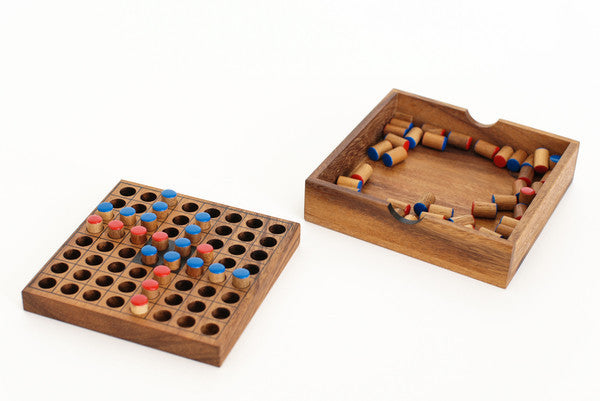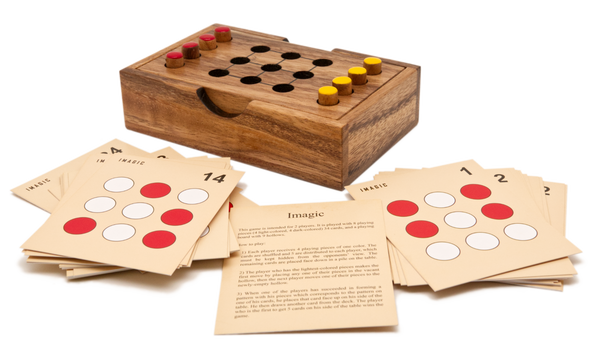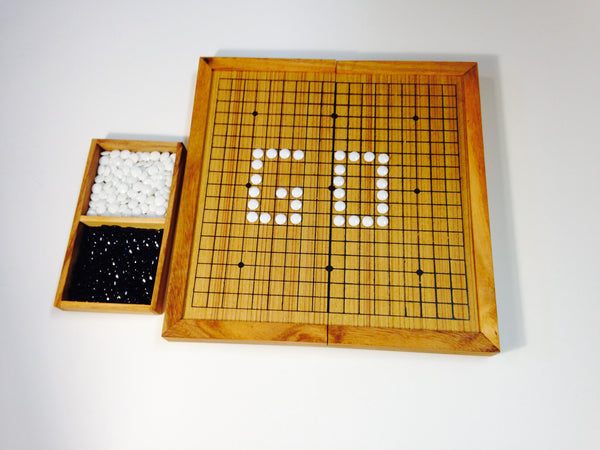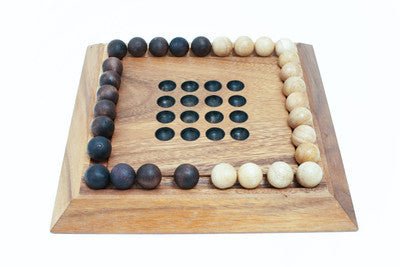Othello (Reversi) - Wooden Game
$22.69
Named after the Shakespeare play due to its traditional black and white pieces Othello was invented in England in the late 1800's. Designed as a simplified version of Go, Othello (or Reversi) offers a fun challenge for all ages.
Initially the board is empty except for 4 pegs - 2 of each color- placed in the central square on opposing corners. On each turn a player places a peg of their color onto the board in such a way as to capture one or more of the opponent's pegs, if you can't capture a peg you must skip your turn. Pegs are captured when a peg placed on the board sandwiches one or more of your opponent's pegs between two pegs of your own color. Pegs can be captured horizontally, vertically and diagonally.
The game is over when the board is full or neither player can move, the player with the most pegs of their color wins.
The board allows you to play another Game: Solitaire.
At the beginning of the game the peg in the center of the board is removed. Moves are made by jumping a peg over an adjacent peg, removing each peg as you pass over it. The aim of the game is to remove all the pegs until only one peg is left in the center of the board.
Imagic
$21.99
This Imagic strategic game is intended for 2 players. It is played on board with 9 hollows. It includes 8 pegs (4 yellow and 4 red) and 34 cards.
How to play:
1) Each player receives 4 playing pieces of one color. The cards are shuffled and 5 are distributed to each player, which must be kept hidden from the opponents’ view. The remaining cards are placed face down in a pile on the table.
2) The player who has the lightest-colored pieces makes the first move by placing any one of their pieces in the vacant hollow, then the next player moves one of their pieces to the newly-empty hollow.
3) When one of the players has succeeded in forming a pattern with his pieces which corresponds to the pattern on one of his cards, he places that card face up on his side of the table. He then draws another card from the deck. The player who is the first to get 5 cards on his side of the table wins the game.
GO - Wooden Strategic Game
Sold Out
GO a strategic wooden game for 2 players.
The game includes a board and two bowls of chess (black and white).
Preparation:
The board cleared; each player chooses his color of chess.
The Game:
The two players take turns to place his/her chess on board. The player with black chess starts first.
A dragon is a line of chess with the same color. When a dragon is strangled, (a line of chess isolated from chess of same color), the dragon (line of chess) is captured by the opponent.
The rules:
The player can choose to give up placing chess on his turn.
If both players decide to give up placing new chess on board on their turns, the game is over
The Winner:
The player with more chess on board wins.
The Last Ball - Wooden Game
Sold Out
The Last Ball
2 players
Another 3d re-imagining of a classic game. Try to be the last player to have balls remaining.
Contents:
Main Board with 16 holes
30 wooden balls: 15 dark balls and 15 light balls
Aim of the game:
To be the player to place the last ball on top of the pyramid.
Start of the game:
Each player alternately, puts a ball from his hand onto the board.
When a player makes a square of 4 of their own color they may take one or two of their balls from the board back to their hand.
At the beginning of a players turn instead of bringing a new ball from their hand they may move a ball of theirs on the board up to a square of four balls(of any color) higher on the board instead of playing a new ball from their hand.
Balls can only be moved or removed if they have no balls on top of them.
END OF THE GAME: The winner is the one who places his last ball at the top of the pyramid





